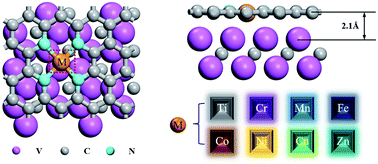Rational design of M–N4–Gr/V2C heterostructures as highly active ORR catalysts: a density functional theory study†
Abstract
Inspired by the composites of N-doped graphene and transition metal-based materials as well as MXene-based materials, heterostructures (M–N4–Gr/V2C) of eight different transition metals (M = Ti, Cr, Mn, Fe, Co, Ni, Cu, and Zn) doped with nitrogen-coordinated graphene and V2C as potential catalysts for the oxygen reduction reaction (ORR) using density functional theory (DFT) were designed and are described herein. The calculations showed that the heterostructure catalysts (except for Zn–N4–Gr/V2C) were thermodynamically stable. Ni–N4–Gr/V2C and Co–N4–Gr/V2C showed higher activities towards the ORR, with overpotentials as low as 0.32 and 0.45 V, respectively. Excellent catalytic performance results were observed from the change in electronic structure caused by the strong interaction between V2C and the graphene layers as well as the synergistic effect between the MN4 groups and the graphene layers. This study further provides insights into the practical application of ORR catalysts for MXene systems through the modulation of the electronic structure of two-dimensional materials.



 Please wait while we load your content...
Please wait while we load your content...